How brands buy trust in a digital age.
The Rise of Branded Content
Around 2015, the revival of branded content exploded under a new name: native advertising. Adapted to the digital age, and previously known as advertorials, branded content has been used for a very long time.
Today more and more people are spending their time online as they talk to friends, watch videos, read the news and shop. Which has meant advertisers have also gone online, leading to one pretty big problem:
It’s becoming increasingly hard to reach, let alone engage, new audiences.
This is especially true with millennials – now the largest generation of Canadians at 27% (Statistics Canada, 2019). They’re also the least likely to trust more traditional forms of online advertising such as banner ads. And you can bet that they’ll skip over that YouTube ad. Which has meant that marketers have had to find new and creative ways to reach this sizeable audience. That is, make advertising not look like advertising!
So, What is ‘Native Advertising’?
Native advertising is “paid advertising where the ad matches the form, feel and function of the content of the media on which it appears ( The Native Advertising Institute, 2019).” And it’s not a new concept. Brands have been using native ads since the 1940’s creating entertaining and informative content to engage with their audiences. In fact, some of the first forms of native ads were brands sponsoring entertainment. Proctor and Gamble (P&G) sponsored and created radio soap operas in the 1940’s to sell their products to a before unreachable audience – housewives (Mission, 2018). And LEGO increased sales for their LEGO toys by 25% after the release of The Lego Movie (Mission, 2019).
According to The Native Advertising Institute, the most common forms of native advertising today are:
- Advertorials in newspapers and magazines,
- Advertiser funded programming on broadcast, or web T.V., and
- Promoted or sponsored posts on social media like Facebook, LinkedIn, and Twitter.
People growing up with the internet want content that’s personalized, relatable, fun and informative.
In fact, 65% of global B2B marketers felt producing engaging content was a top challenge when maximizing the impact of their initiatives (Gocheva, 2016).
Native ads offer meaningful content to the reader in a way that does not disrupt their experience. For example, Adobe’s long-form article on virtual shopping published in The New York Times is an example of an advertorial. The well-researched native ad offers valuable insights and statistics regarding shopping trends (AdEspresso by Hootsuite, 2017). The tone of the article is editorial in nature and not too sales-y.
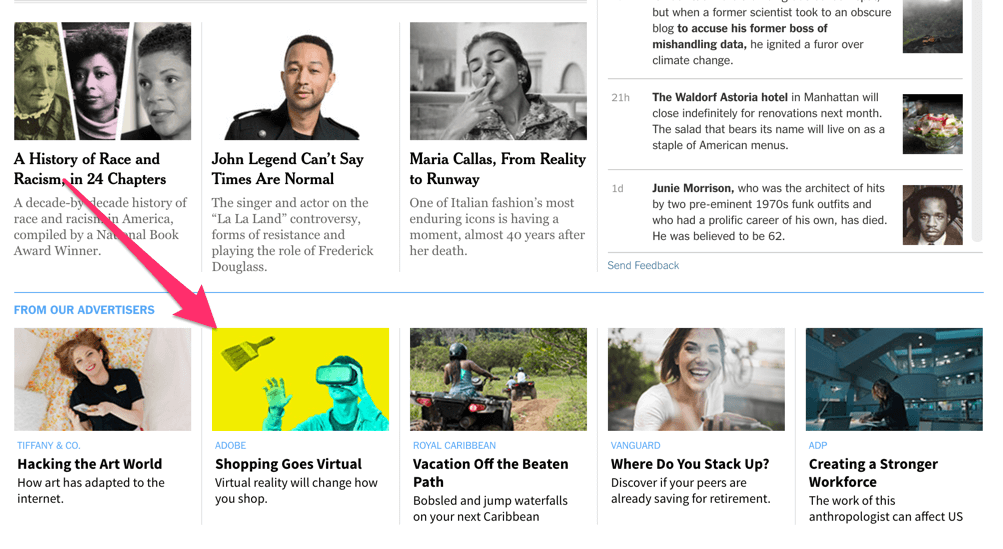
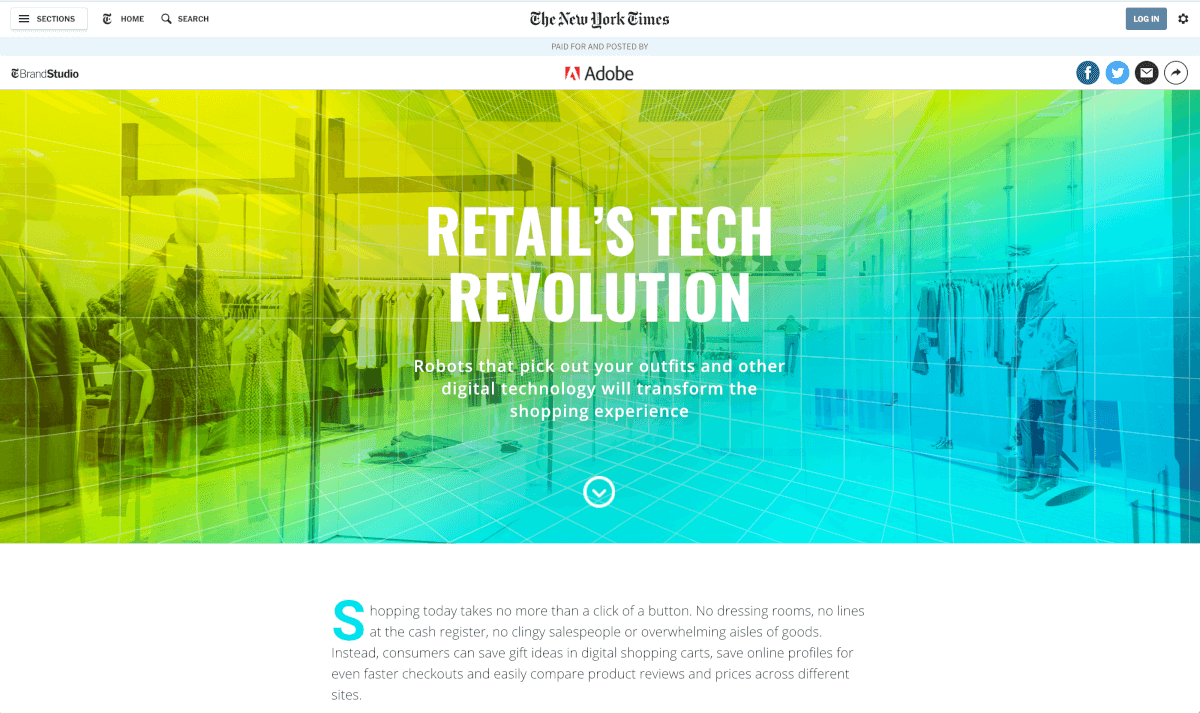
Sponsored content on social media is another example of native advertising. Such as Taco Bell’s Snap Chat Lens for Cinco De Mayo 2016. With new technology comes new ways for advertisers to engage their audiences, and this type of sponsored content shows that consumers love fun and entertaining experiences. The Taco Bell filter received 224 million views in one day – making it one of Taco Bell’s best performing pieces of content.
Even B2B brands can take advantage of native advertising. For example, Xerox collaborated with The Atlantic to create an interactive portal featuring articles by leading experts and an e-book on productivity and growth hacking. Each piece of content was meant to solve a key challenge – either in alignment, productivity or agility.
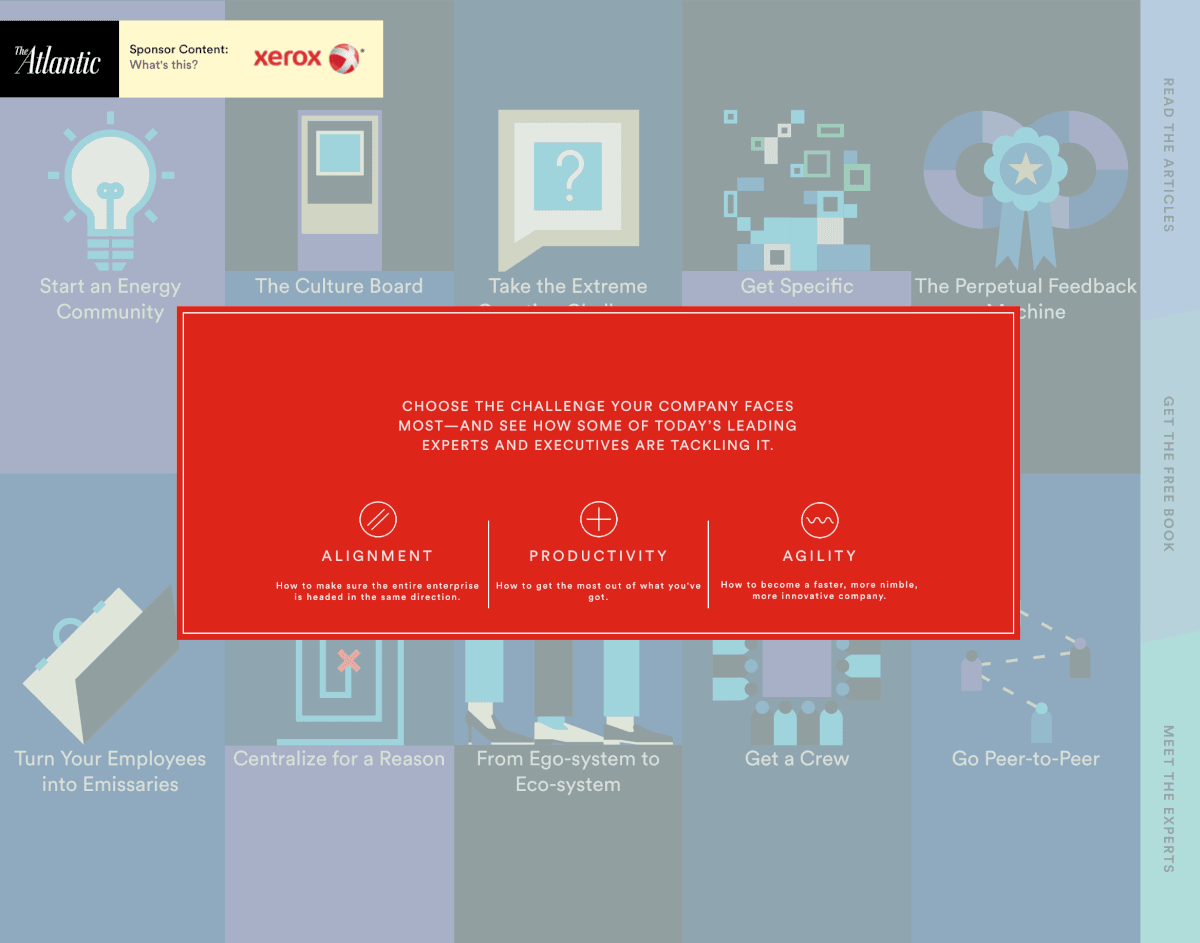
Buying Trust to Create Market Demand
Native advertising works because the content doesn’t really look like advertising. It matches the look, feel and function of the media format in which it appears (click here for more examples of native advertising). And rarely is the content about the brand, but rather about something that the consumer deeply cares about.
According to Johanna Lessmann, Social Media Executive for the popular UK athleisure wear GymShark, generation Z and millennials are a lot more entrepreneurial and a lot less likely to commit to a brand (Lessmann, 2019). They’re a little more skeptical than older generations, often shopping around before making any big purchasing decisions.
And they really, really, don’t like to be sold to. In fact, 82% of Americans ignore online advertisements altogether (BusinessWire, 2014).
But, that’s not to say that they won’t click on a discount ad. It’s just not likely the first thing they’ll do. And if it is the first thing they do, they’re likely not very loyal to your brand, and will jump at the next offer.
The power of native advertising fundamentally comes down to trust and building long-term relationships with your audience. People buy from those they trust. And many people follow and trust the recommendations of influencers and prestige news outlets online.
Native advertising differs from other branded content (such as content marketing) in one very important way: you’re buying trust instead of building it organically.
So why buy trust? Because sometimes content marketing just can’t cut through the noise. Whether it’s an influencer on social media or an article sponsored in The New York Times, native advertising can influence the most influential audiences. It delivers a compelling story to the right people, on a platform that they trust.
According to Lessmann, native advertising is most effective when used to grow brand awareness, engagement, and credibility.
It fills the gap between brand publishing and banner adverts. It’s a less… annoying way of catching a consumer’s attention.
Native ads also perform better over other types of ads. In fact, consumers look at native ads 53% more than display ads (Outbrain, 2019).
Are Native Ads Misleading?
Critics of native advertising often argue that native ads are inherently misleading because they look like editorial content. However, research shows this is simply not true. A study by Stanford University found that people aren’t misled by native ads. They actually are able to identify it…and they don’t care if the content they are reading is an ad! (Outbrain, 2019).
Similarly a study conducted by BBC Storyworks shows that 64% of consumers are happy to read content funded by brands as long as it is clearly labelled (Native Advertising Institute, 2019). Good, quality content offers something for the brand and the audience. But that’s not to say native advertising can’t flop.
When dishonest brands partner with influencers, it’s often the consumer who pays. This is perhaps best demonstrated in the Netflix documentary: Fyre: The Greatest Party That Never Happened.
Fyre was an app that let ordinary people book talent. Meant to be the “uber of booking talent,” a young entrepreneur, Billy McFarland, decided to throw a massive festival to promote the app. Influencers and celebrities were paid (or offered a free ticket) to post an orange tile with a link to the Fyre Festival on their social media page. The post went viral, and within 48 hours 95% of the tickets were sold (Wang, 2019).
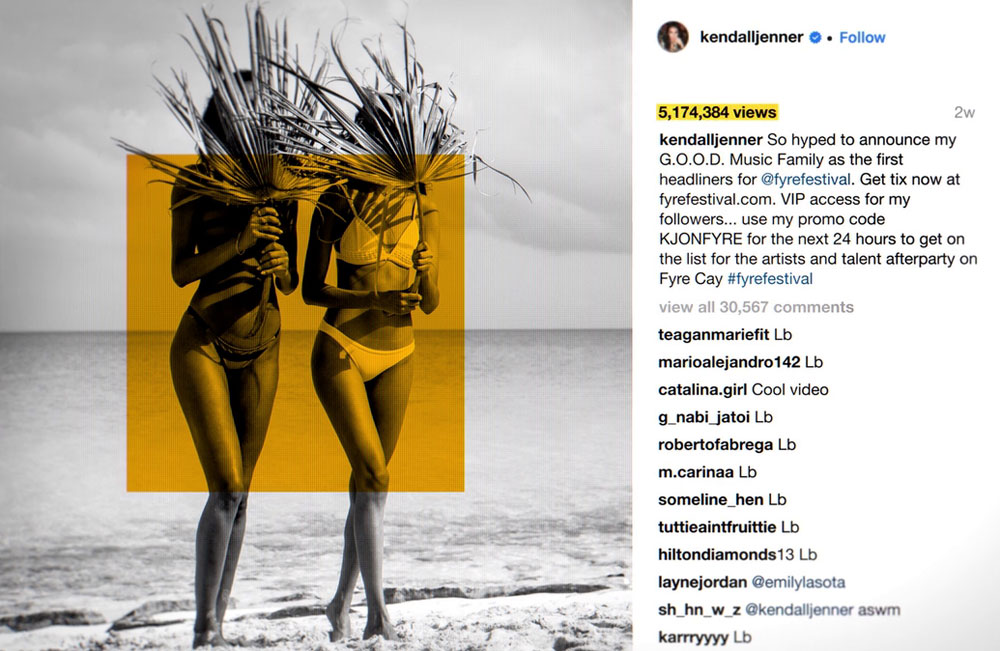
McFarland had 8 weeks to execute the festival, which was built entirely on social media buzz. The festival was a flop. Unable to execute the festival in time, the result was an unsafe environment for attendees, Bahamian people left unpaid, eight lawsuits, and McFarland was sentenced to six years in prison for fraud. McFarland managed to host what is likely the worst festival ever.
Quality Content = Brand Advantage
Furthermore, some argue that content marketing delivers better return on investment generating more leads than native advertising (Morrison, 2016). Native advertising often delivers more engagement, with metrics such as the number of visits, session duration, scroll depth, social shares and comments. And while conversion metrics such as leads generated are important and necessary to overall business health, engagement metrics are arguably often a better indication of overall brand advantage.
Lessmann explains that native advertising tactics such as influencer marketing works best on brands that are community-based and niche. Gymshark got success after it asked influencers on social media to wear their clothing line, hoping that they’d speak positively about it. And the results were pretty incredible. Started by a 19-year-old Birmingham student, Gymshark has since used influencers to grow their business into a £100m company in just seven years (Bearne, 2018).
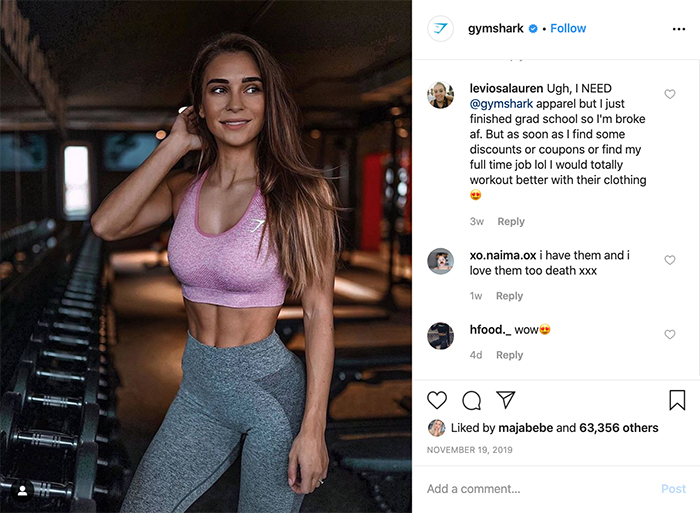
Native Advertising or Content Marketing?
So, is native advertising right for you? It depends on your goals. Native advertising works best to increase the reach of your content and to build a brand’s image in a niche market. It may be that native advertising does not deliver immediate results, but rather contributes to more sustainable brand growth.
Even established brands like Netflix, who have partnered with The Washington Post and The New York Times on multiple campaigns, can benefit from native advertising. For example, Netflix partnered with The New York Times to promote Orange is the New Black ahead of its second season, writing a series of journalistic pieces on Women Inmate’s: Why the Male Model doesn’t work (Morey, 2019). Through creating meaningful video and interview content about life in prison, the article sought to educate viewers on what it’s like to be a woman in prison. The hope with this type of native advertising is that the content is interesting enough for your followers to share – positioning your brand as a leader in the industry. Native advertising is not for everyone. But when used correctly, it can lead to an established brand advantage.
Native ads are a tactic that should be considered amongst a broader content marketing strategy.
Content models such as the Hero, Hub & Hygiene can certainly shed further light on native advertising. Ultimately, when done well, native advertising can help growing and established brands create quality content, helping them to stand out from the crowd. Give us a call if you’d like to learn more about this subject.
AdEspresso by Hootsuite. (2017). (2017, March 15). 19 Amazing Native Advertising Ad Examples. Retrieved December 2019, from https://adespresso.com/blog/19-amazing-native-advertising-ad-examples/.
Bearne, S. (2018, October 1). The 26-year-old with a £100m sportswear brand. Retrieved December 2019, from https://www.bbc.com/news/business-45246999.
Business Wire. (2014, February 11). Goo Study: Most of Us Ignore Online Ads. Retrieved December 2019, from https://www.businesswire.com/news/home/20140211005607/en/Goo-Study-Ignore-Online-Ads.
Gocheva, N. (2016, October 21). Seminar 5: Branding meets content: digital trends in native advertising and branded content. Presentation. Global Communications, Cardiff University.
Lessmann, J. (2019, November 23). Native advertising at Gymshark. Interview by Alyssa Korte.
Mission. (2018, January 25). Branded Content: The What, Why, When, and How. Retrieved December 2019, from https://medium.com/the-mission/branded-content-the-what-why-when-and-how-fb9426dc3e14.
Mission. (2019, January 28). 5 Reasons The LEGO Movie Is the Greatest Branded Content Ever. Retrieved December 2019, from https://medium.com/the-mission/5-reasons-the-lego-movie-is-the-greatest-branded-content-ever-f73fd444bb0e.
Morey, R. (2019, September 12). 10 Award Winning Native Advertising Campaigns to Learn From. Retrieved December 2019, from https://pagely.com/blog/native-advertising/.
Morrison, K. (2016, February 18). Content Marketing vs. Native Advertising: Which Is More Effective on Social? Retrieved December 2019, from https://www.adweek.com/digital/content-marketing-vs-native-advertising-which-is-more-effective-on-social/.
Native Advertising Institute. (2018, July 24). 4 Classic Misconceptions About Native Advertising. Retrieved December 2019, from https://nativeadvertisinginstitute.com/blog/misconceptions-about-native-advertising/.
The Native Advertising Institute. (2019). Native Advertising Definition. Retrieved December 2019, from https://nativeadvertisinginstitute.com/resources/native-advertising-definition/.
Outbrain. (2019). What Is Native Advertising – How it works. Retrieved December 2, 2019 from https://www.outbrain.com/native-advertising/.
Statistics Canada. (2019, April 18). This article in the Economic Insights series examines economic well-being of millennials by comparing their household balance sheets to those of previous generations of young Canadians. Retrieved December 2019, from https://www150.statcan.gc.ca/n1/pub/11-626-x/11-626-x2019006-eng.htm.
Wang, Y. (2019, February 11). Three things Fyre Festival taught us about influencer marketing – Yenan Wang, PHD UK. Retrieved December 2, 2019, from https://www.phdmedia.com/three-things-fyre-festival-taught-us-about-influencer-marketing-yenan-wang-phd-uk/.

